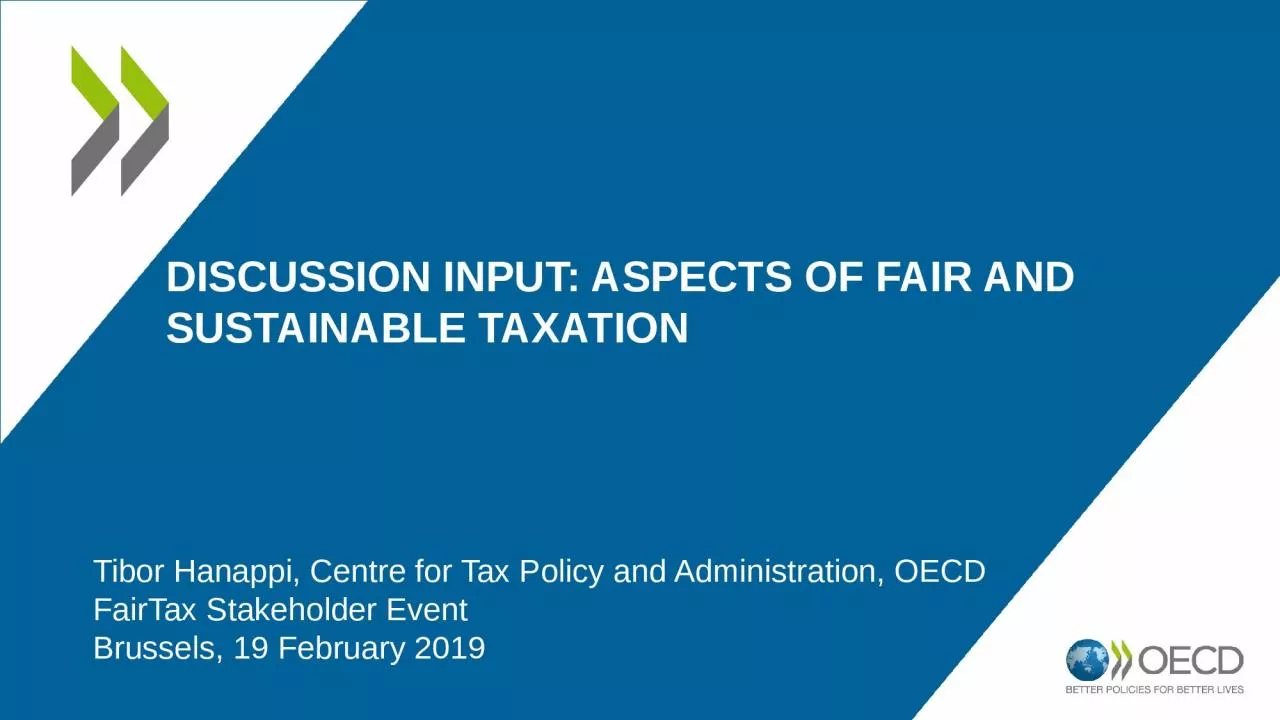

OF FAIR AND SUSTAINABLE TAXATION Tibor Hanappi Centre for Tax Policy and Administration OECD FairTax Stakeholder Event Brussels 19 February 2019 Tax Challenges arising from Digitalisation ID: 1020900
Download Presentation The PPT/PDF document "DISCUSSION INPUT: ASPECTS" is the property of its rightful owner. Permission is granted to download and print the materials on this web site for personal, non-commercial use only, and to display it on your personal computer provided you do not modify the materials and that you retain all copyright notices contained in the materials. By downloading content from our website, you accept the terms of this agreement.
1. DISCUSSION INPUT: ASPECTS OF FAIR AND SUSTAINABLE TAXATIONTibor Hanappi, Centre for Tax Policy and Administration, OECDFairTax Stakeholder EventBrussels, 19 February 2019
2. Tax Challenges arising from DigitalisationThree key factors prevalent in certain highly digitalised businesses (HDBs)Cross-jurisdictional scale without massReliance on intangible assets, including IPData available on growing importance of investment in intangiblesIntangible assets crucial value driver of HDBsData, user participation and their synergies with IPAbility to remotely develop and interact with a global customer baseFacilitates relocation of production processes & centralisation of functionsHDBs often highly involved in economic life of a jurisdiction with little/no physical presenceData value cycle (e.g. collection, storage, analysis) becomes a key aspect of HDBsUsers increasingly involved in value creation process of some HDBsNot always exclusiveor specific to HDBs Complex reality
3. Tax Challenges arising from DigitalisationCharacteristics frequently observed in HDBs and their interaction with international tax rules – potential implications? Cross-jurisdictional scale without massReliance on intangible assetsData and user participationImpact on the distribution of taxing rights e.g., increasing share of profits from cross-border activities not taxed in market jurisdiction?Mobility of key profit allocation factors, and difficulty to determine ownership/management e.g., increasing share of profits can easily be shifted around within an MNE group with limited changes in functions? Potential new source/material contribution to value creation not captured by the current tax frameworke.g., ability of business that exploits data and user-generated content to have little/no physical presence in jurisdiction of users?
4. Task Force on the Digital Economy (TFDE)Initial Mandate(September 2013)Subsidiary Body of the CFA Work mandated by the Action Plan on BEPS (Action 1)BEPS Action 1 Report delivered in October 2015New Mandate(January 2017)Subsidiary Body of the Inclusive Framework on BEPS (IF)Follow-up work mandated by BEPS Action 1 ReportInterim Report delivered in March 2018IF & TFDEMore than 113 jurisdictions working together on an equal footingFinal Report by end 2020
5. Different Country PerspectivesBroad spectrum of divergent countries’ views, that can generally be described as falling within three groupsFailure to take into consideration user-generated value in certain HDBs create misalignments between where profits are taxed and where value is created This does not undermine the principles of the existing international tax frameworkOnly targeted changes neededDigitalisation and globalisation pose challenges to the effectiveness of some basic concepts underlying the existing international tax framework (e.g. transfer pricing, PE definition)These challenges are not exclusive or specific to highly digitalised business modelsBEPS measures have largely addressed double non-taxation, and more time is required to assess their full impact Generally satisfied with the existing tax system and do not currently see the need for any further reformFirst GroupSecond GroupThird Group
6. Review of the Key ConceptsCommitment of the members of the IF to…Undertake a coherent and concurrent review of the profit allocation and nexus rulesWork towards a consensus-based solution by 2020(with an update to be provided in 2019)12Taking forward this commitment will require to… Refine the analysis of value creation in HDBsTest the feasibility of technical solutionsClarify the parameters of such revision WP1WP6TFDE
7. What happened since the Interim Report?7Focus on developing consensus-based solutionsCountry proposalsUser participationSignificant Economic PresenceMarketing intangiblesIntensive TFDE work since April 2018GLOBE
8. Proposed Way Forward8BEPS issuesAllocation of taxing rightsComprehensive work on 2 pillars « Without Prejudice » BasisRelease of a Policy Note by the Inclusive Framework on 29 January 2019
9. Key Challenges: Summary9DigitalInterim measures for taxation of e-servicesLong-term challenges of nexus and profit attributionLeveraging opportunities for improved compliance New challenges such as crypto- currencies Tax AdministrationTax PolicyTechnically complexDivergent positionsGlobal engagement
10. Next Steps10
11. Contact detailsTibor HanappiTax Policy and Statistics DivisionCentre for Tax Policy and Administration2, rue André Pascal - 75775 Paris Cedex 16 Tel: +33 1 45 24 15 14 – Fax: +33 1 44 30 63 51Giorgia.Maffini@oecd.org || www.oecd.org/tax11
12. Categories of Relevant MeasuresDiverted Profits Tax (e.g. UK and Australia)Base-Erosion and Anti-abuse Tax (e.g. US)Sectoral taxes, such as for advertisement (e.g. Hungary) or audio-visual content (e.g. France)Levy on Digital Transactions (Italy)Equalisation Levy (e.g. India)Broader royalty definitions (e.g. Philippines, Malaysia, UK)Technical service fees (e.g. UN Model Tax Convention)Online advertising (e.g. Thailand)Digital presence-type of PEs (e.g. Israel, India, Slovakia)Virtual Service PE (e.g. Saudi Arabia)Alternative PE thresholds Withholding TaxesTurnover TaxesSpecific regimes for large MNEs